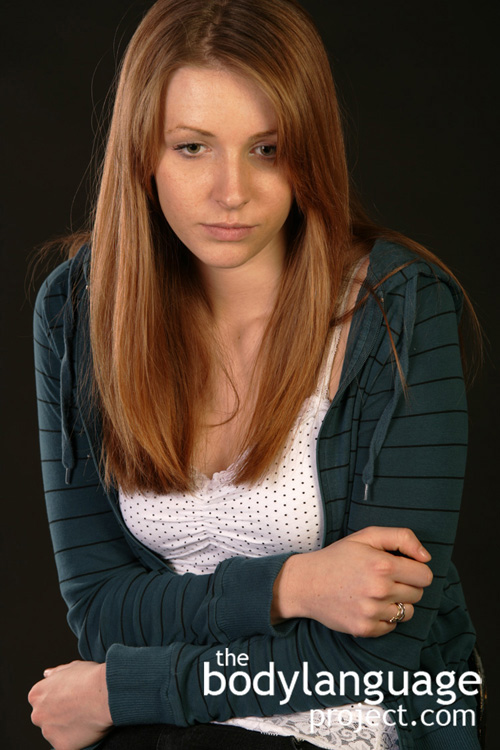Body Language of Blank Face or Deadpan Face
 Cue: Blank Face or Deadpan Face
Cue: Blank Face or Deadpan Face
Synonym(s): Poker Face (the), Pan Face, Stone Face, Block Face.
Description: A neutral, relaxed face, showing no expression. The face and jaw is relaxed and the eyes are generally vacant.
In One Sentence: A blank face is a signal that a person is vacant and is internalizing emotions or thoughts.
How To Use it: Use the deadpan face in poker when bluffing (or otherwise) such that people can not read your emotions. The blank face is also helpful when trying to appear in control of a situation. Emotional outbursts have been shown to be counterproductive in business settings. A face that lacks expression, especially when under high stress, shows others that you can keep things under control.
Context: High Stress.
Verbal Translation: “I really don’t want to be read or give any emotions away so I’m just going to wipe any hint of life from my face.”
Variant: During emotional downtime a person can also support a vacant expression as they relax inside their own mind for some time – even while in public.
Cue In Action: His opponent was searching and studying his face, he wasn’t sure if he had a good hand or was just bluffing. All he saw staring back at him was a Deadpan face.
Meaning and/or Motivation: This expression is used to either conceal emotion (on purpose) or be an actual reflection of a lack of emotion such as watching television, during deep thought or boredom.
Cue Cluster: When someone doesn’t want to be read, they will usually freeze solid and reduce arm and hand movements, their head will be still and unchanging. They don’t want to give others any clues at to their inner thoughts.
Body Language Category: Boredom, Closed body language, Defensive, Emotional body language, Masked emotions, Stressful body language.
Resources:
Burgress R. and C. Baldassarre. 2006. Ultimate guide to poker tells: devastate opponents by reading body language, table talk, chip moves, and much more. Chicago, Triumph Books.
Baumeister, Jenny-Charlotte; Raffaella Ida Rumiati and Francesco Foroni. When the Mask Falls: The Role of Facial Motor Resonance in Memory for Emotional Language. Acta Psychologica. 2015. 155: 29–36. http://bodylanguageproject.com/articles/stiff-poker-face-interrupts-emotional-memories/
Browning, E. ; Huynh, C. ; Peissig, J. Show Me Your Poker Face: Are Poker Players Better at Recognizing Emotional Expressions? Journal of Vision. 2013. 13(9): 599-599.
Carvajal, Fernando ; Rubio, Sandra ; Serrano, Juan ; Ríos-Lago, Marcos ; Alvarez-Linera, Juan ; Pacheco, Lara ; Martín, Pilar. Is a neutral expression also a neutral stimulus? A study with functional magnetic resonance. Experimental Brain Research, 2013. 228(4): 467-479.
Channell, Marie Moore ; Barth, Joan M. Individual differences in preschoolers’ emotion content memory: the role of emotion knowledge. Journal of experimental child psychology. 2013. 115(3): 552-61.
Ekas, Naomi V. ; Haltigan, John D. ; Messinger, Daniel S. The Dynamic Still-Face Effect: Do Infants Decrease Bidding over Time when Parents Are Not Responsive?
Developmental Psychology. 2013. 49(6): 1027-1035.
Giuseppe Blasi; Ahmad R. Hariri; Guilna Alce; Paolo Taurisano; Fabio Sambataro; Saumitra Das; Alessandro Bertolino; Daniel R. Weinberger and Venkata S. Mattay. Preferential Amygdala Reactivity to the Negative Assessment of Neutral Faces. 2009. 6(9): 847-853.
Heisel, Marnin ; Mongrain, Myriam. Facial Expressions and Ambivalence: Looking for Conflict in All the Right Faces. Journal of Nonverbal Behavior. 2004. 28(1): 35-52.
Kraft, Tara L ; Pressman, Sarah D. Grin and Bear It. Psychological Science. 2012. 23(11): 1372-1378.
King, Laura A. Ambivalence over emotional expression and reading emotions in situations and faces. Journal of Personality and Social Psychology. 1998 74(3): 753(10)
LaBarbera, J. D., C. E. Izard, P. Vietze, and S. A. Parisi (1976). “Four- and Six-Month-Old Infants’ Visual Responses to Joy, Anger, and Neutral Expressions.” In Child Development (Vol. 47), pp. 535-38.
Mignault, Alain and Chaudhuri, Avi. The Many Faces of a Neutral Face: Head Tilt and Perception of Dominance and Emotion. Journal of Nonverbal Behavior. 2003 27(2): 111-132.
Matsumoto, David ; Hwang, Hyisung C. Desteno, David (editor). Judgments of Subtle Facial Expressions of Emotion. Emotion. 2014. 14(2): 349-357.
Pinkham, Amy E. ; Brensinger, Colleen ; Kohler, Christian ; Gur, Raquel E. ; Gur, Ruben C. Actively paranoid patients with schizophrenia over attribute anger to neutral faces. Schizophrenia Research. 2011 125(2): 174-178.
Rothman, Naomi B. Steering Sheep: How Expressed Emotional Ambivalence Elicits Dominance in Interdependent Decision Making Contexts. Organizational Behavior and Human Decision Processes. 2011. 116: 66-82.
http://bodylanguageproject.com/articles/ambivalent-facial-expression-form-dominance-study
Sturman, Edward D. Invluntary Subordination and Its Relation to Personality, Mood,
and Submissive Behavior. Psychological Assessment. 2011. 23(1): 262-276 DOI: 10.1037/a0021499
http://bodylanguageproject.com/articles/nonverbal-submission-men-women-depression-critical-examination-use-disuse-submission/
Schlicht, Erik J.; Shinsuke Shimojo; Colin F. Camerer; Peter Battaglia and Ken Nakayama. Human Wagering Behavior Depends on Opponents’ Faces. PLOS one. July 2010. 5(7): e11663. doi:10.1371/journal.pone.0011663.g001
http://bodylanguageproject.com/articles/which-faces-bluff-best-in-poker/
Shah, Rebecca ; Lewis, Michael. Locating the neutral expression in the facial-emotion space. Visual Cognition. 2003. 10(5): 549-566.
Trevarthen, Colwyn (1977). “Descriptive Analysis of Infant Communicative Behaviour.” In H. R. Schaffer, ed., Studies in Mother-Infant Interaction (London: Academic Press), pp. 227-70.
Woud, Marcella L. ; Becker, Eni S. ; Lange, Wolf – Gero ; Rinck, Mike. Effects of approach-avoidance training on implicit and explicit evaluations of neutral, angry, and smiling face stimuli.(Relationships & Communications). Psychological Reports. 2013. 113(1): 1211(18).
Wolf K, Mass R, Ingenbleek T, Kiefer F, Naber D et al. (2005) The facial pattern of disgust, appetence, excited joy and relaxed joy: an improved facial EMG study. Scand J Psychol 46: 403-409. doi: 10.1111/j.1467-9450.2005.00471.x. PubMed: 16179022.
Vanderhasselt, Marie – Anne ; Kühn, Simone ; De Raedt, Rudi. Put on your poker face’: neural systems supporting the anticipation for expressive suppression and cognitive reappraisal. Social Cognitive and Affective Neuroscience. 2013 8(8): 903-910.
